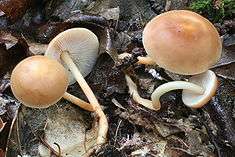Gymnopus dryophilus
Gymnopus dryophilus is a mushroom commonly found in temperate woodlands of Europe and North America. It is generally saprophytic, but occasionally also attacks living wood. It belongs to section Levipedes of the genus, being characterized by a smooth stem having no hairs at the base (in contrast to section Vestipedes).[1][2] Until recently it was most frequently known as Collybia dryophila.
| Gymnopus dryophilus | |
|---|---|
 | |
| Scientific classification | |
| Kingdom: | |
| Phylum: | |
| Class: | |
| Subclass: | |
| Order: | |
| Family: | |
| Genus: | |
| Species: | G. dryophilus |
| Binomial name | |
| Gymnopus dryophilus (Bull.) Murrill (1916) | |
| Synonyms | |
|
Agaricus dryophilus | |
| Gymnopus dryophilus | |
|---|---|
float | |
| gills on hymenium | |
| cap is convex | |
| hymenium is adnexed or free | |
| stipe is bare | |
| spore print is white to cream | |
| ecology is saprotrophic | |
| edibility: edible | |
Description
The cap is 2–5 centimetres (0.79–1.97 in) in diameter, convex, and russet to ochre. The gills, which are only thinly attached to the stem, are whitish and crowded, and the spore powder is white. The bald stem is up to 8 centimetres (3.1 in) long by 4 mm in diameter.[3][4][5]
Microscopically the spores are 6×3 µm in size and slightly tear-shaped, there are lobed club-shapedcystidia (15-50 µm × 2-6 µm), and the hyphae on the cap cuticle can also have lobes. It is contended that G. dryophilus in fact consists of a complex of different species and that several new species (including G. brunneolus, G. earleae and G. subsulphureus) should be split off from it.[6] However these species are not generally recognized at present.[7]
Distribution and habitat
This fungus is very common in northern hemisphere temperate woodlands (so much so that it is sometimes considered a "weed" mushroom[6]). It fruits from April to December[8] and is often seen when there are few other fungi in evidence. Although the Greek epithet dryophilus means "lover of oak trees", it is also found with other broad-leaved trees and with conifers.
Edibility
Gymnopus dryophilus is generally considered to be edible, though not worthwhile.[4][9] It is recommended not to eat the stem, which is tough.
It has been found to contain anti-inflammatory beta-glucans[10]
References
- See "Levipedes" page of "A revision of Collybia s.l. in the northeastern United States & adjacent Canada", Roy Halling.
- Meinhard Moser, translated by Simon Plant: Keys to Agarics and Boleti (Roger Phillips 1983) ISBN 0-9508486-0-3
- Courtecuisse, R. & Duhem, B. (1994) "Guide des champignons de France et d'Europe" Delachaux et Niestlé ISBN 2-603-00953-2, also available in English
- Marcel Bon: The Mushrooms and Toadstools of Britain and North-Western Europe Hodder & Stoughton ISBN 0-340-39935-X.
- Phillips, Roger (1981). Mushrooms and other fungi of Great Britain & Europe London: Pan Books Ltd.
- Kuo, M. (2008, May). Gymnopus dryophilus at the MushroomExpert.Com Web site)
- Index Fungorum
- Régis Courtecuisse : "Mushrooms of Britain & Europe" (Harper Collins 1999). ISBN 0-00-220012-0
- Phillips, Roger (2010). Mushrooms and Other Fungi of North America. Buffalo, NY: Firefly Books. p. 70. ISBN 978-1-55407-651-2.
- Pacheco-Sanchez M, Boutin Y, Angers P, Gosselin A, Tweddell RJ. (2006). A bioactive (1→3)-, (1→4)-β-D-glucan from Collybia dryophila and other mushrooms. Mycologia. 98(2): 180-5.
External links
- Index Fungorum
- USDA ARS Fungal Database
- “Gymnopus dryophilus” by Robert Sasata, Healing-Mushrooms.net, December, 2007.
- Kuo, M. (2008, May) Gymnopus dryophilus at the MushroomExpert.Com Web site